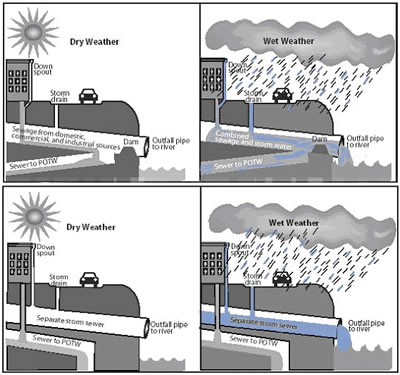What are Combined Sewer Systems and CSOs?
Centralized sanitary sewer systems collect and convey sanitary sewage (consisting of domestic, commercial, and industrial wastewater) in pipes, pump stations, storage tanks, and other infrastructure to the wastewater treatment plant (WWTP) for treatment and discharge to a receiving water. Many cities also collect and convey stormwater runoff to receiving waters in centralized storm sewer systems.
Separate sewer systems collect and convey only sanitary sewage to the WWTP while municipal separate storm sewers (MS4s) collect and convey stormwater runoff directly to receiving waters.
Combined sewer systems are designed to collect sanitary sewage and stormwater runoff in a single pipe system for conveyance to a POTW treatment plant. These were common in the mid- to late-19th century before centralized wastewater treatment became the solution to protecting public health of the increasing populations located in urban areas. The majority of the combined sewer systems in Kentucky are located along the Ohio River because most of these river towns are older. Originally, combined sewer systems discharged continuously into receiving waters from outfalls throughout the sewer system to minimize the contact between people and sanitary sewage. After centralized wastewater treatment became available, regulators (also called diversions), such as orifices and weir dams, and interceptor sewers were added to the combined sewer system that directed the dry weather sanitary sewage to the WWTP. During precipitation events such as rainfall or snowmelt, the regulators convey some combined sewage to the WWTP but allow flows that exceed downstream capacity to go to combined sewer overflow (CSO) outfalls to discharge directly to receiving waters. Without the regulators and CSO outfalls, the combined sanitary sewage and stormwater would overwhelm the capacity of the conveyance and treatment plant, potentially causing releases of untreated sewage in buildings, in streets or yards, or partially treated sewage from the treatment plant.

Separate sanitary sewers are now the standard for conveyance of wastewater to a centralized wastewater treatment facility and construction of new combined sewers is prohibited except as allowed under 401 KAR 5:005, Section 8.
As of January 1, 2019, Kentucky has the following combined sewer systems and permitted CSO outfalls:
City of Ashland
| Boyd | KY0022373
| 8 |
City of Catlettsburg
| Boyd
| KY0035467
| 1
|
City of Frankfort
| Franklin
| KY0022861
| 14
|
City of Harlan
| Harlan
| KY0026093
| 1
|
Henderson Water Utility
| Henderson
| KY0020711
| 10
|
Louisville/Jefferson County Metropolitan Sewer District
| Jefferson
| KY0022411
| 98
|
City of loyall
| Harlan
| KY0026115
| 3
|
Maysville Utility Commission
| Mason
| KY0020257
| 10
|
City of Morganfield
| Union
| KY0021440
| 2
|
Paducah-McCracken County Joint Sewer Agency
| McCracken
| KY0022799
| 11
|
City of Pineville
| Bell
| KY0024058
| 2
|
Regional Water Resource Agency
| Daviess
| KY0020095
| 8
|
Sanitation District No. 1 of Northern Kentucky
| Boone
Campbell
Kenton
| KY0021466
| 88
|